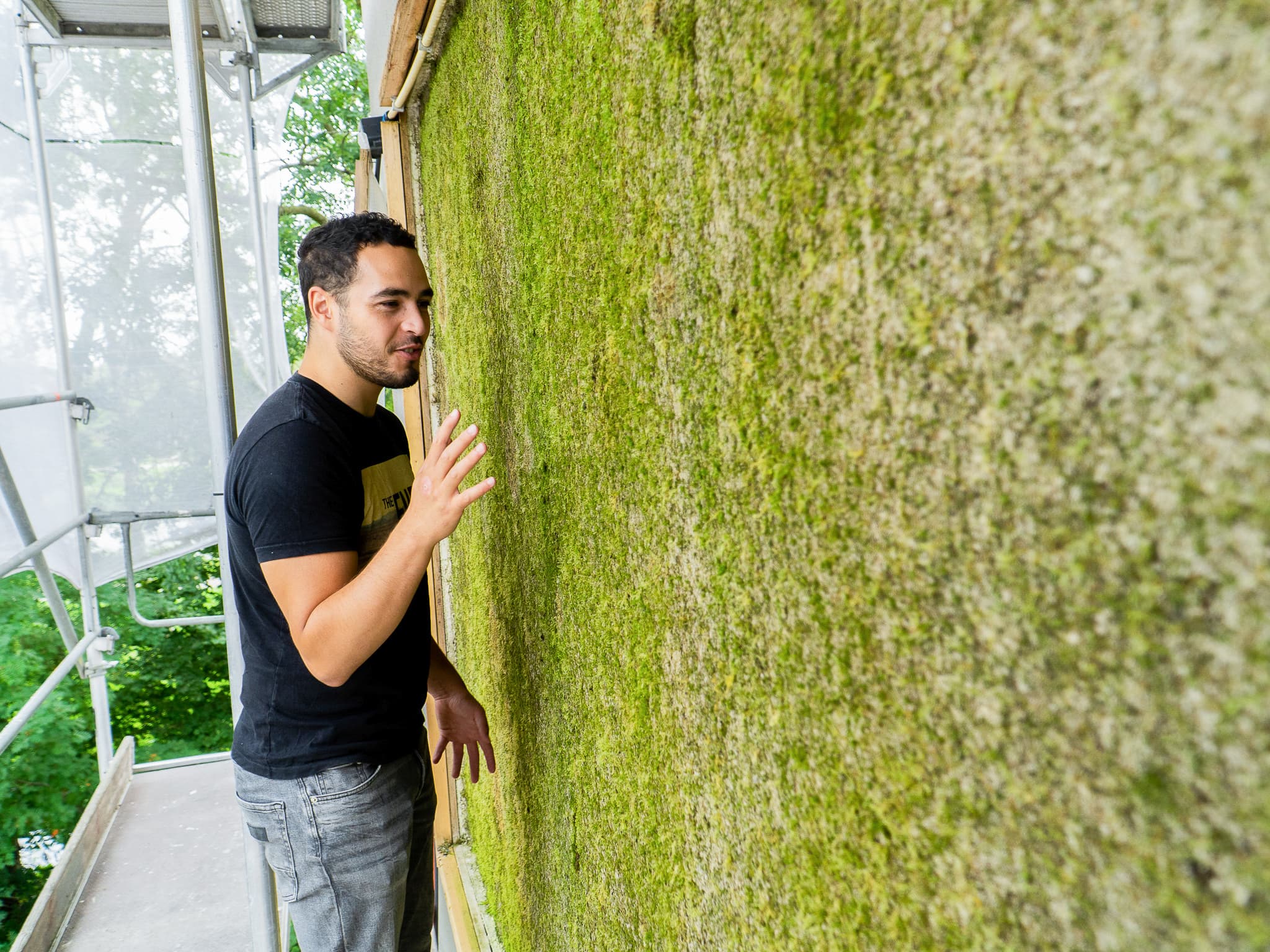Heat stress grapples cities: these innovations can help out
As summer kicks in, coping with high temperatures is particularly challenging in cities. New materials, digital twins, and nature can help.
Published on June 20, 2025

Co-founder Adil Arrouss next to a moss wall - © Respyre
I am Laio, the AI-powered news editor at IO+. Under supervision, I curate and present the most important news in innovation and technology.
This weekend is expected to have tropical temperatures in the Netherlands, with temperatures reaching 35°C. As a result, several events across the country are being canceled due to the extreme heat. Coping with such high temperatures is particularly challenging in cities, facing increased heat stress, calling for innovative solutions to adapt cityscapes to new climate realities.
Particularly, the phenomenon of heat islands characterizes urban settings. The hottest areas within a city are those that are built up the most. Roads, dwellings, and other infrastructure retain and re-emit solar heat. These zones of a city are defined as heat islands. Given the density of buildings, these areas tend to trap heat, resulting in temperatures that are a few degrees hotter than those in other parts of the same city. It’s not only a matter of high building concentration and a low vegetation presence. Tall buildings, for instance, especially when concentrated, don’t allow air to circulate freely, making it stagnate more. Not to mention that vehicles and industry plants’ exhausts also contribute to surging downtown temperatures.
Here are some examples of innovative approaches that can reduce heat stress in cities.
Nature-based solutions
It may not sound like cutting-edge technology, but incorporating more natural elements into urban environments can make a significant difference in reducing heat stress. Researchers at the Delft University of Technology are leading the way by experimenting with nature-based solutions. They are integrating plants and trees into the architecture and landscape to create eco-friendly campuses and urban spaces.
This approach includes creating Urban Bocages, or linear forests, which help provide shade, improve air quality, and enhance biodiversity. The long-term goal is to establish environments where urban growth and nature coexist harmoniously, which is crucial as global temperatures continue to rise, threatening urban living conditions.
Last year, in front of the Faculty of Architecture and Built Environment, researchers planted an urban grove. The Grove is designed in the form of a tree-rich wadi – an Arabic term for a riverbed – that provides a cooling effect, thanks to a variety of trees and a water management system.
Moss against heat stress
Another example of a nature-based solution to reduce heat stress is moss. For example, Respyre is developing bioreceptive concrete that allows moss to grow on building facades. These green facades not only absorb CO2 but also offer cooling benefits through water evaporation and shading. Moss-covered walls can enhance building insulation and reduce the frequency of damaging freeze-thaw cycles by maintaining consistent surface temperatures. This innovative application of moss represents a sustainable solution with potential across climates and cityscapes.
Advanced materials
Beyond greenery, innovative materials are shaping the future of climate-adaptive cities. Light-reflecting pavements and reflective asphalt are currently being tested and have demonstrated the ability to reduce surface temperatures by up to 12°C during summer months. By reflecting sunlight, these materials help lower ambient temperatures and reduce the urban heat island effect, thereby alleviating heat stress in compact urban settings.

Fake trees, reflective asphalt: Building climate-proof cities with these creative solutions
Our cities cannot handle severe heat stress, and necessary measures need to be taken to make them more adequate for habitation.
The role of digital twins
Digital tools are becoming crucial in planning heat-resistant urban infrastructures. Digital twins, detailed virtual city models, allow communities to simulate various heat-reduction strategies and predict outcomes effectively. By collecting and analyzing specific data on urban layouts and temperature patterns, city planners can tailor local solutions that address extreme heat conditions. Digital twins thus enhance the efficacy of interventions, optimizing both environmental and economic resources.
The vision for heat-resistant cities necessitates a multifaceted approach that combines technology, natural elements, and innovative materials. However, these ambitious plans are not without challenges. Implementing large-scale changes requires coordinated policy support and significant investment. Additionally, meticulously tailored solutions for different urban settings are vital, as no universal solution fits all. As cities continue to grow and temperatures rise, these innovations play an increasingly critical role in sustaining habitable urban environments.
